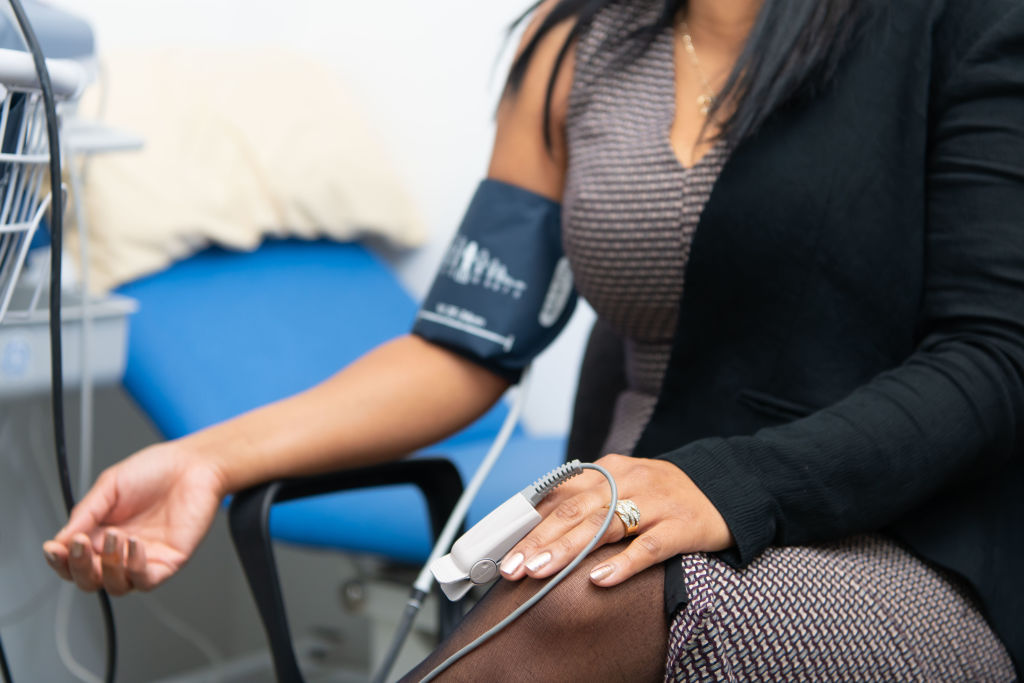Little Caesars Helping The Homeless
We are all one paycheck away from being homeless.
Scientists can now manipulate brains using smartphones: study
Mind control has never been so high-tech.
Scientists have created a tiny, smartphone-controlled brain implant capable of selectively manipulating brain cell circuits — and uncovering neurological problems, such as Parkinson’s, Alzheimer’s, addiction and depression, a new study finds.
A team of engineers with the Korea Advanced Institute of Science and Technology and neuroscientists from the University of Washington published their joint research Monday in the journal Nature Biomedical Engineering.
“We are eager to use the device for complex pharmacological studies, which could help us develop new therapeutics for pain, addiction and emotional disorders,” says University of Washington professor Michael Bruchas.
Using “Lego-like replaceable drug cartridges and powerful Bluetooth” energy, the tech works by targeting specific neurons using drugs and light, Science Daily reports. The replaceable cartridges allow the same brain circuits to be studied for months.
The tech has only been studied in mice so far, with the implant inserted into the rodents’ brains via a hair-thin probe. Scientists then controlled the implant with their smartphone, changing drug quantities and light sequencing with the touch of a finger and manipulating the mice’s movement for over a month.
Previously, the most cutting-edge neuroscience tech required bulky metal tubes and optic fibers that caused brain lesions and didn’t last as long.
Article via NYPost
Mass Shootings Can Be Contagious, Research Shows
There were three high-profile shootings across the country in one week: The shooting in Gilroy, Calif., on July 28, and then the back-to-back shootings in El Paso, Texas, and Dayton, Ohio, this past weekend.
That’s no surprise, say scientists who study mass shootings. Research shows that these incidents usually occur in clusters and tend to be contagious. Intensive media coverage seems to drive the contagion, the researchers say.
Back in 2014 and 2015, researchers at Arizona State University analyzed data on cases of mass violence. They included USA Today‘s data on mass killings (defined as four or more people killed using any means, including guns) from 2006 to 2013, data on school shootings between 1998 and 2013, and mass shootings (defined as incidents in which three people were shot, not necessarily killed) between 2005 and 2013 collected by the Brady Campaign to Prevent Gun Violence.
The lead researcher, Sherry Towers, a faculty research associate at Arizona State University, had spent most of her career modeling the spread of infectious diseases — like Ebola, influenza and sexually transmitted diseases. She wanted to know whether cases of mass violence spread contagiously, like in a disease outbreak.
So, she plugged each data set into a mathematical model.
“What we found was that for the mass killings — so these are high-profile mass killings where there’s at least four people killed — there was significant evidence of contagion,” says Towers. “We also found significant evidence of contagion in the school shootings.”
In other words, school shootings and other shootings with four or more deaths spread like a contagion — each shooting tends to spark more shootings.
“So one happens and you see another few happen right after that,” says Jillian Peterson, a criminologist at Hamline University in Minnesota and founder of the nonpartisan think tank, The Violence Project. She wasn’t involved in the Arizona State research but has found similar patterns in her own research.
Towers and her colleagues also found that what set apart shootings that were contagious was the amount of media coverage they received. “In the incidences where there were four or more people killed, and even school shootings, those tended to get national and even international media attention,” says Towers.
She also found that there is a window when a shooting is most likely to lead to more incidents — about two weeks. Towers and her team published their results in 2015.
It’s a form of social contagion, says Peterson, somewhat like a suicide contagion — that’s when a high-profile suicide leads to more people to take their own lives. For example, following the suicide of actor Robin Williams, researchers documented a 10% spike in suicides in the months following his death. Vulnerable individuals who are already struggling with suicidal thoughts read or watched news reports of the actor’s death and then took their own lives.
Mass shooting contagion is similar, she says.
Peterson has interviewed living mass shooters in prison and people who knew such perpetrators and has found that these individuals often start out feeling suicidal.
“We can show about 80 percent were actively suicidal prior to the shooting,” she says.
Now, the vast majority of people who are suicidal don’t attack others. And people with any kind of mental health problems aren’t more likely to be violent than others. In fact, they are more likely to be victims of violence than those without mental illness.
But Peterson says that in very rare cases, a tiny minority of people considering suicide go down the path of violence toward others. She has come to think of mass shootings as a form of suicide. “They’re angry, horrible suicides that take a lot of people with them,” she says. “The shooter never intends to live; there’s never a getaway plan. Typically they tend to think of this [as] their kind of last moment.”
Other researchers have documented the same in studies of active shooters.
“About half of the school shooters I’ve studied died by suicide in their attack,” Peter Langman, a clinical psychologist in Allentown, Pa., told NPR earlier this year. “It’s often a mix of severe depression and anguish and desperation driving them to end their own lives.”
Vulnerable individuals who are also angry and already considering violence may read or watch the news of a mass shooting and identify with the shooter and be inspired by them.
“So a mass shooting happens and then vulnerable individuals who are actively suicidal and in crisis and hear about the shooting and see this as kind of a script that they could also follow,” she says.
Access to guns and a venue allows them to follow that script.
“There is this element of wanting notoriety in death that you don’t have in life,” Peterson says. “So when one happens and it makes headlines and the names and pictures are everywhere and the whole world is talking about it, that becomes something that other people see as a possibility for themselves.”
Now it’s hard to know yet whether the shooter in Dayton, Ohio, was consciously influenced by the shooter in El Paso, the one in Gilroy, Calif., or another shooting.
But Sherry Towers notes that there’s clear evidence that the shooter in El Paso, Texas, was inspired by the shooting at a mosque in New Zealand back in March.
“It’s in his manifesto that he published online,” says Towers. “He mentions that he wanted to emulate the Christchurch, New Zealand, shooting.”
Peterson and other researchers who study mass shootings think the media should avoid showing the shooters’ images and dwelling on their life histories and motives. “The fact that we give them that notoriety is problematic,” says Peterson.
Article via NPR
STRANGE LOOKING YouTube shooter angry at company for demonetizing her videos…
Donald Trump Responds to Backlash Regarding His Tweet About Orlando
Pewdiepie & Candace Owens blamed for New Zealand m@ssacre+ Was The “Manifesto” Designed to Troll?
Researchers find way to measure blood pressure with a selfie video
But it might not work for all skin tones just yet.
In the near future, you might not have to traipse to your doctor or pharmacy to determine your blood pressure. Researchers have figured out a way to accurately measure it with your phone’s camera.
A selfie video might be all you need to find out your blood pressure, per a study by researchers in Canada and China. University of Toronto developmental psychologist Kang Lee and his postdoctoral researcher Paul Zheng developed a technology called transdermal optical imaging (TOI).
It works by taking into account the fact our facial skin is translucent. Optical sensors on smartphones can capture red light reflected from hemoglobin under our skin, which allows TOI to visualize and measure changes in blood flow.
The researchers used the tech to analyze two-minute selfie videos of 1,328 adults that were captured with an iPhone camera. Compared with standard methods of determining blood pressure, they were able to measure three types of blood pressure with around 95 percent accuracy. TOI can also analyze faces in pre-recorded videos.
Lee co-founded Nuralogix, a startup that released an app called Anura. When you record a 30-second video selfie, the app provides you with resting heart rate and stress level measurements. Nuralogix plans to release another version of the app in China this fall that adds blood pressure measurements to the mix.
On the privacy front, Lee says the app uploads results of the analysis to the cloud, but not people’s video selfies. Nuralogix plans to offer access to more detailed health data for a monthly fee. The team eventually hopes to track other health attributes with the tech, including blood glucose levels, hemoglobin and cholesterol.
However, the tech needs extra research to make it more accurate, Lee said. The vast majority of study participants were of East Asian or European descent, and it didn’t include people with very dark or fair skin. Considering Latinx and African-American folks in the US are at above-average risk of hypertension, TOI may not yet be accurate enough for the people who’d perhaps benefit most from it. Expanding the diversity of research participants will improve the tech’s accuracy, while finding people with very high or low blood pressure who don’t medicate for it has proven a challenge too.
The technology could help people at risk of hypertension- or hypotension-related issues to track their blood pressure without the need for a dedicated device. It could also help people with limited healthcare access, such as folks who live in remote areas. “If you set up a computer or your phone, you can get a doctor who is, let’s say, in Toronto and then you can talk to each other and diagnose simultaneously,” Lee said.
Article via Engadget
A fraternity member gave ‘step-by-step’ directions to 5 people who then killed themselves, a lawsuit alleges
A former fraternity member and student at Truman State University in Missouri allegedly provided “step-by-step” directions to five people who died by suicide in 2016 and 2017, according to a lawsuit filed Wednesday against the university, the fraternity and the student. The member of the Alpha Kappa Lambda fraternity told people he considered himself a superhero nicknamed “peacemaker,” parents of two of the deceased allege in the suit, which identifies the accused as Brandon Grossheim.
Grossheim counseled people with “step-by-step directions” for using their own free will and to “deal with depression,” according to a news release issued by lawyers for the parents of Alex Mullins, 21, and Joshua Thomas, 18. Grossheim gave no comment to CNN’s repeated requests.
“Both the University and the Fraternity were aware that the Plaintiff victims were vulnerable and suffered from depression, yet they still allowed this suspicious fraternity brother to be alone and have unfettered access to the victims,” the release states. “This tragedy was preventable.
“The lawsuit alleges negligence and wrongful death and seeks unspecified damages. “It is our understanding that a lawsuit has been filed by the parents of Alex Mullens and Joshua Thomas, two members of the Xi Chapter of the Fraternity of Alpha Kappa Lambda, in connection with their deaths. Our sympathy continues for the families and friends of our lost Brothers of the Xi Chapter of Alpha Kappa Lambda,” the fraternity said a statement.”
The death of these young men during the 2016-2017 school year greatly impacted the Xi Chapter and the surrounding community. Like Truman State University, The Fraternity of Alpha Kappa Lambda, Inc., the National Fraternity, strongly disagrees with the allegations in the lawsuit to the extent those allegations are directed against it and will vigorously defend the lawsuit. The Fraternity of Alpha Kappa Lambda does not comment on pending litigation and therefore, will not comment further.”
Article via CNN
Netflix 13 Reasons Why Season 3
13 Reasons Why Season 3 premieres August 23rd!! This program may not be suitable for all vulnerable and impressionable preteen and or young adult viewers VIEWER DISCRETION ADVISED
National Suicide Prevention Hotline 1-800-273-8255
CDC warns of crypto parasite in pools, water parks
A new report from the CDC shows outbreaks of an illness caused by a parasite in swimming pools are on the rise.
Healthy eating can turn into dangerous obsession, researchers say
Article via UPI
“Orthorexia is really more than just healthy eating,” said researcher Jennifer Mills. “It’s healthy eating taken to the extreme, where it’s starting to cause problems for people in their lives and starting to feel quite out of control.”
When eating healthy becomes an around-the-clock obsession, it could be a sign of trouble.
An extreme preoccupation with clean eating is an eating disorder called orthorexia nervosa. Though less well-known than anorexia nervosa or bulimia — and not as well-documented — a new study review says orthorexia can also have serious emotional and physical consequences.
“Orthorexia is really more than just healthy eating,” said review co-author Jennifer Mills, an associate professor of health at York University in Toronto. “It’s healthy eating taken to the extreme, where it’s starting to cause problems for people in their lives and starting to feel quite out of control.”
The review of published research from around the world on the disorder was recently published in the journal Appetite.
Mills and her colleague Sarah McComb looked at risk factors and links between orthorexia and other mental disorders. Orthorexia, unlike some other eating disorders, is not yet recognized in the standard psychiatric manuals.
Healthy eating to the extreme
No clear line divides healthy eating from orthorexia’s extreme eating.
The foods someone with orthorexia might avoid are the same as those someone with healthy habits might avoid — such as preservatives, anything artificial, salt, sugar, fat, dairy, other animal products, genetically modified foods or those that aren’t organic.
It boils down to whether avoiding foods leads to obsession — excessive time and energy thinking and fretting about what to eat. Some people may eliminate numerous categories of food and eat only a very small number of things.
People with orthorexia are typically less concerned about cutting calories than with the perceived quality of their food.
“They often are taking more and more time thinking about the foods they’re needing to purchase, particular foods, that makes it really difficult for them to just live their lives,” said Lauren Smolar, who wasn’t involved with the review. She is director of programs for the nonprofit National Eating Disorders Association. “It can result in malnutrition or weight loss in a really difficult and potentially dangerous way.”
A person with orthorexia might be so focused on types of food and how that food is prepared that it becomes impossible to eat anything not made at home.
“It can lead to all kinds of related problems, like isolation, or not being able to eat at other people’s houses or not being able to eat in a restaurant for fear that the food won’t have been prepared in a very pure, clean way,” Mills said. “Those are the kinds of things that might lead someone to feel that it’s taking over their life.”
Cultural trends could be fueling those fears, Mills said. With the internet and social media, people have unlimited access to information — some of it good and some not based on scientific evidence.
Eating trends that restrict certain foods are concerning, said Smolar, who added that dieting is one of the biggest triggers for eating disorders. All foods are good in moderation, she said, and a diverse diet is best.
Though many think of eating disorders as a problem affecting young women, orthorexia appears to be experienced equally by men and women, the study found. People who follow a vegan or vegetarian diet or who have a poor body image are at a higher risk.
For some, the underlying cause is another eating disorder, and clean eating is seen as a socially acceptable way to restrict calories, Mills said. For others, obsessive-compulsive or anxiety disorder may manifest in the need to eat in this very rigid way.
“In that sense it is very similar to what we see in other kinds of obsessive-compulsive disorder, where somebody might be afraid that they’re going to get sick or they’re going to be getting exposed to germs if they don’t wash their hands enough or if they don’t do something in a very particular way,” Mills said.
Getting help
Orthorexia should be taken seriously, Mills said.
Talk to your primary care doctor about any concerns. Meeting with a psychologist who specializes in anxiety disorders, eating disorders or body image also can be helpful, she said.
NEDA offers an online screening tool that assesses risk and a helpline where you can talk through concerns and learn about resources.
“As awareness grows, more people are recognizing symptoms and seeking opportunities for help,” Smolar said. “It’s something that I think we still have a lot to learn about.”
More information
Do you have an eating disorder? The National Eating Disorders Association has an online screening tool.
Fecal Transplant Patient Killed by Superbug Traced to Donor Stool
Article via Gizmodo
An aesthetically unpleasant but genuinely promising medical treatment—a fecal transplant—may come with more serious risks than previously thought. This week, the Food and Drug Administration issued a warning about the treatment, after receiving reports of two people coming down with serious drug-resistant infections following the procedure. One patient ultimately died.
Fecal transplants, or fecal microbiota transplantation (FMT), have been explored as a way to reset the delicate bacterial environment of a person’s gut. A recipient’s gut microbiome is scrubbed out as much as possible with heavy-duty antibiotics, then the donor’s gut bacteria is transplanted over, which will hopefully seed the gut with a healthy balance of bacteria again. Most FMTs are performed via an enema, though doctors are studying if a capsule of the donor’s gut bacteria taken orally can work just as well.
A gut microbiome imbalance is thought to contribute to conditions like irritable bowel syndrome, inflammatory bowel disease (IBD), and possibly even metabolic diseases like obesity. So far, though, the clearest potential for FMT has been for people with a recurrent, often excruciating infection of Clostridium difficile, or C. diff. Cure rates of recurrent C. diff with FMT have hovered as high as 90 percent in small trials.
FMT at this point is an experimental treatment, however. And trials are still ongoing that are trying to figure out how to make the procedure as effective and safe as possible. According to the FDA, the two superbug infections were spotted in such a trial.
The patients were part of an investigational FMT trial, and received a transplant from the same donor. Soon after, they developed an invasive infection caused by multidrug-resistant Escherichia coli (E.coli). Despite doctors’ efforts, one patient didn’t make it through. In the aftermath, the donor’s remaining samples were tested and the same E. coli strain was discovered.
“FDA is informing members of the medical and scientific communities and other interested persons of the potential risk of transmission of [multidrug-resistant organisms] by FMT and the resultant serious adverse reactions that may occur,” the agency said in its safety communication.
It’s likely that the pre-existing health of both patients contributed to the severity of their illnesses, since both had weakened immune systems. But the infections could have been prevented had doctors in the trial been looking for these bacteria in donors to begin with, the FDA said.
In 2013, as FMT trials began taking off, the agency announced it would take a hands-off approach in regulating its early use for C. diff infections (generally, any new drug or treatment for a disease needs to go through a lengthy FDA approval process before it can be widely available). So long as patients were told upfront about the potential risks and experimental nature of the treatment by doctors, it would be less strict in approving or supervising new clinical trials. But as a result of these tragic cases, the agency is now demanding that all investigational trials preemptively screen their donors for risk factors that would make them more likely to have superbugs, as well as to test their donor samples for these bacteria. Doctors should tell their volunteers beforehand about these now-discovered serious risks, too.
“Today’s safety communication underscores the importance of why new therapies are thoroughly studied to ensure the benefits of taking them outweigh the risks to patients, and we will continue to aggressively monitor clinical trials to ensure patients are protected when safety concerns arise,” Peter Marks, director of FDA’s Center for Biologics Evaluation and Research, said in an FDA statement.











